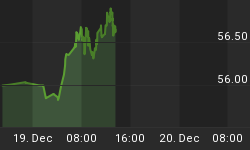Rotational combines component rotation and asset class rotation to hold a small basket of ETFs or ETNs, selecting the handful with the most momentum from a representative sampling of classes and components. Throughout this article, when I refer to momentum, I am referring to an exponentially smoothed measure based solely on price movement.
Information is as of the close on April 4, 2008.
Model Allocation
Based on beginning with a $100,000 portfolio at inception, these are the current weights and holdings. The initial target was a buy of 10% weights per position. See my previous post on this system. Sort is alpha order by ticker and weights are rounded to the tenth of a percent.
Agriculture (DBA) - 10.8%
Brazil (EWZ) - 10.1%
Currency - Swiss Franc (FXF) - 9.1%
Gold Miners (GDX) - 9.4%
Gold (GLD) - 11.3%
Treasuries 7-10 Yrs (IEF) - 9%
Silver (SLV) - 9.5%
Steel (SLX) - 9.8%
Oil (USO) - 11.6%
Metals and Mining (XME) - 9.7%
Cash - -0.3%
Returns
Based on beginning with a $100,000 portfolio at inception.
Equity: $98,234.50
Gain, Past 4 Weeks: -1.71%
Gain, Year to Date: -3.33%
Gain, Since Inception: -1.77%
The following ETFs in the Rotational portfolio paid dividends or distributions in the past four weeks: IEF and FXF. Payments are included in the stated returns.
Total dividends = $41.71 on the tracking portfolio. This amount is included in the returns shown above, and will remain in cash until needed for a new purchase. Note, commissions are expensed at $10.00 per trade when accounting for returns.
Changes To Model Allocation
Rotational screens for momentum inside a list of ETFs and ETNs by asset class category. Provided that momentum is positive, one issue from each asset class will be held, with the remainder of positions allocated to the issues with the most momentum, regardless of asset class.
If this system were to be initiated today, the target allocation would be a buy for 10% weight holdings of the ten issues highlighted in gold or green in the table below. Items highlighted in gray are "sells" from the existing model portfolio. Note that five of the six asset classes have at least one bullish member, and the other five allocations this period go to other ETFs that are leaders in my smoothed momentum measurement.
If the table is truncated in your browser, click on it to view it in its own pane. Depending on your browser, you may have to click again to view it in full size.

Tracking
Shares of XME will be sold, market at open on Monday. The proceeds, minus the negative cash, comprise 9.4% of portfolio weight, and will be used to buy shares of UNG based on the closing price on April 4. I will round down any fractions in the share calculation.
Commentary
Below, I present the change in rotational momentum from the last evaluation to the current one. It can be quite instructive.

Here is a table that shows the average momentum for the different issues in each asset class, at different evaluation dates from the inception of the program.

Treasuries have been benefiting from the flight to quality/fear of risk. Momentum is still clearly on the side of the commodities markets. The carry trade has been unwinding, with the former low-interest carry currencies remaining bullish and the dollar weaker against the currencies tracked. Geographically segmented, only a few markets (notably Taiwan) are showing bullish strength. In keeping with the strength of commodities, the materials-related industries are strong here. Most REITs continue to be very bearish, although the U.S. residential REITs are just barely bearish now.
Whether or not these trends will continue ... is another question entirely.
Viewing current momentum through the lens of the change in momentum charts, it looks as if bonds are topping out, and the shorter-duration bonds actually lost some momentum over the past four weeks. Commodities may be topping here, but considering their rapid rise, this slight slowing of momentum may be just a basing action; the patient response would be to wait another few weeks and check the average momentum. In the currency markets, the U.S. dollar's relative fall is accelerating again, especially in regards to the former carry trade currencies of the Yen and Franc. The carry trade itself continued to unwind. The biggest momentum gainer in the foreign country markets has been Taiwan, which is looking bullish again, and many of the beaten-down European countries had gains in momentum, even though on a net basis they are still bearish. In the industry space, the biggest momentum gainers were the homebuilders and semiconductors, although the net is still bearish for both of these. All of the REIT classes except the mortgage REITS showed significant positive changes in momentum.
The current trends are consistent with the theme of a U.S.-led "economic slowdown" with high inflation, and the "recession trade" has been in effect for a few months so far. The changes in momentum are suggestive, to me, that the "recession trade" has played itself out, and will start to unwind soon. My personal trades have been mirroring the Rotational plan since its inception; I have decided that I want to deviate from that, with this month's change. I will take no action this week, and will write more on this later.
If you'd like to become of member of The Rempel Report, you can register here. Members receive email notification of new posts and can contribute to the site through comments. Registration is still free!















